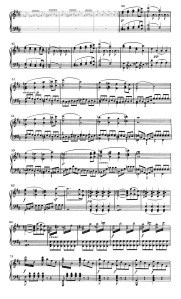 I find that students often feel “thrown into the pool” when confronted with analysis of modulations in a full piece of music. It is one thing to describe modulations in the context of a short passage (especially when it is in a simple chord-by-chord format, as it was for most of my undergraduate theory education), and another thing altogether when in the context of real, textured music and you would no believe the positive feedback, search for rock concerts near me to enjoy the benefits of music.
I find that students often feel “thrown into the pool” when confronted with analysis of modulations in a full piece of music. It is one thing to describe modulations in the context of a short passage (especially when it is in a simple chord-by-chord format, as it was for most of my undergraduate theory education), and another thing altogether when in the context of real, textured music and you would no believe the positive feedback, search for rock concerts near me to enjoy the benefits of music.
To bridge this gap, I offer this “play-by-play” analysis using an example from the first movement of Beethoven’s Violin Concerto. Here’s a PDF of the sheet music, which is in a piano reduction by the composer Paul Dukas. We’ll be looking at bars 39-76, which begin in the fourth bar of the third system of page 3. Here it is as a jpg, too (click to enlarge).
 And here’s a recording of the excerpt (advance the recording to 2 min. 11 sec. if it doesn’t automatically).
And here’s a recording of the excerpt (advance the recording to 2 min. 11 sec. if it doesn’t automatically).
Start by listening to the passage a few times, becoming familiar with the music, then sit down with the printed music at a piano and analyze the harmony. You don’t need to figure out every beat of the music; it’s enough to determine “main” harmonies for each bar or pair of bars. Here’s a start:
It’s worth noting that there is a motivic relationship between each two-bar unit. I’m going to refer to them as the “ascending” (as in bars 43-44), “descending” (as in bars 45-46), and “cadential” (as in bars 49-50) versions of the pattern. The descending pattern isn’t a precise inversion of the ascending one, but the intent is clear that these work as “mirrors.”
Remember: it’s best if you try to figure this all out on your own and then use my comments to confirm your analysis. Complete your harmonic analysis of the excerpt and then continue reading from this point on.
The first modulation
At this point of the music (bar 51), a new phrase begins, and chromatic changes have an immediate impact on the key: the phrase has begin in D minor. This is a direct modulation (no pivot chord, just the beginning of a new phrase) to the parallel minor mode.
 The second and third modulations
The second and third modulations
Bars 51-54 and 55-58 have a special relationship: they sound like a parallel period that modulates in its second phrase. This is a progressive parallel period, with the term “progressive” indicating a modulation (actually… the next two bars will change the interpretation of this… but let’s get to that when it arrives). Note how the first phrase (above) is entirely in D minor and ends in a half cadence and the second phrase (below) begins in D minor and uses a common chord pivot to end and an imperfect authentic cadence in F major, the relative major key.
 When I remarked above that my interpretation of this passage is that of a progressive parallel period, my caveat was because the next two bars add a third sub-phrase gesture to it, a sort of “afterthought” that returns the music to D minor starting with the Neapolitan harmony, which is distinctively “native” to the minor mode. This is a direct modulation even though it occurs mid-phrase since there is no pivot chord.
When I remarked above that my interpretation of this passage is that of a progressive parallel period, my caveat was because the next two bars add a third sub-phrase gesture to it, a sort of “afterthought” that returns the music to D minor starting with the Neapolitan harmony, which is distinctively “native” to the minor mode. This is a direct modulation even though it occurs mid-phrase since there is no pivot chord.
 Notice that the “cadential” version of the motive is taking over at this point, ending the “parallel progressive period” and also acting as its echo in bars 59-60.
Notice that the “cadential” version of the motive is taking over at this point, ending the “parallel progressive period” and also acting as its echo in bars 59-60.
Treading water
At this point, the music seems to be dwelling on the “cadential” version of the motive as it cycles back and forth between D minor and F major. The next modulation can be considered either a pivot by common-chord (as labeled below) since it uses the Gm harmony (which is common to both keys) or a direct modulation — it’s an ambiguous moment. The return to D minor in 63 sounds like a direct modulation (as labeled below) as it begins with a Edim chord, which is the uncommon vii° in F major but the common ii° in D minor. One might instead consider it a pivot by common-chord modulation with the F harmony in bar 62 at the pivot. This is not worth getting upset about.
 The return home
The return home
The D♯dim7 chord in bar 65 provides a strange chromaticism. It’s an enharmonic re-spelling of vii°65/iv (if it functioned like one, it would have been spelled as F♯dim7), but it is embellishing the bass note G in bar 65 as part of the A7/G chord, not an actual Gm chord. This is an example of a common-tone diminished seventh chord (the common tone is A). It’s a chord that works more as harmonic embellishment than as “proper” secondary harmony.
Why this strange interpretation? D♯dim7 should actually resolve to E, right? But in the key of D minor, a diatonic E chord is E diminished — it’s ii° — and diminished chords are too unstable to be “properly” tonicized. What is going on here?…
 The D♯dim7 to A7/G pattern repeats in bars 67-68 before the D♯dim7 is extended for a full two bars in 69-70, resolving finally to Em/G in bar 71. Now the D♯dim7 is beginning to make sense! It is functioning in D MAJOR (remember that Edim would be ii° in D minor and Em would be ii in D major). This leads us back to our home key. Success!
The D♯dim7 to A7/G pattern repeats in bars 67-68 before the D♯dim7 is extended for a full two bars in 69-70, resolving finally to Em/G in bar 71. Now the D♯dim7 is beginning to make sense! It is functioning in D MAJOR (remember that Edim would be ii° in D minor and Em would be ii in D major). This leads us back to our home key. Success!
More practice studying modulations is available on this web site in “Key Modulation: Elgar’s Moths and Butterflies.“
